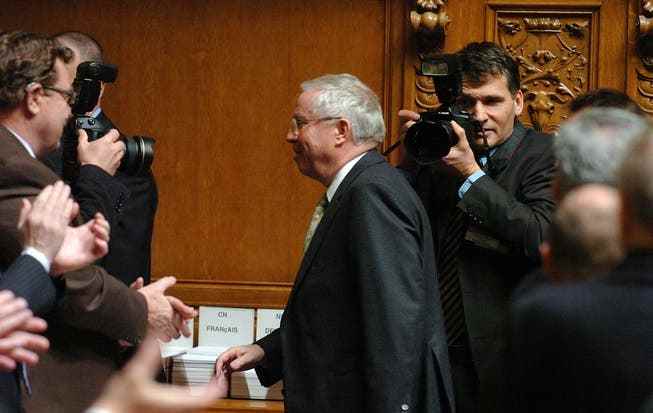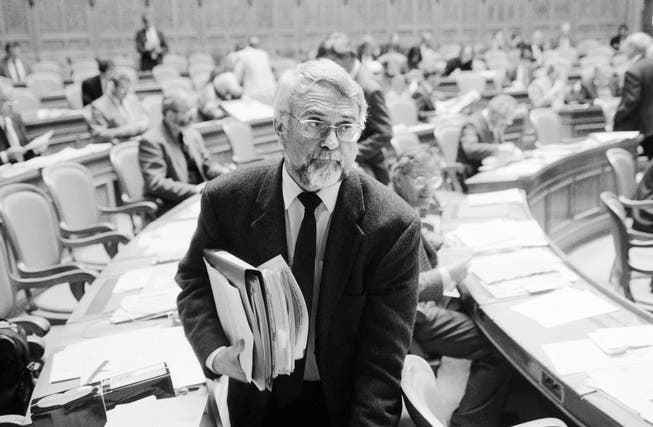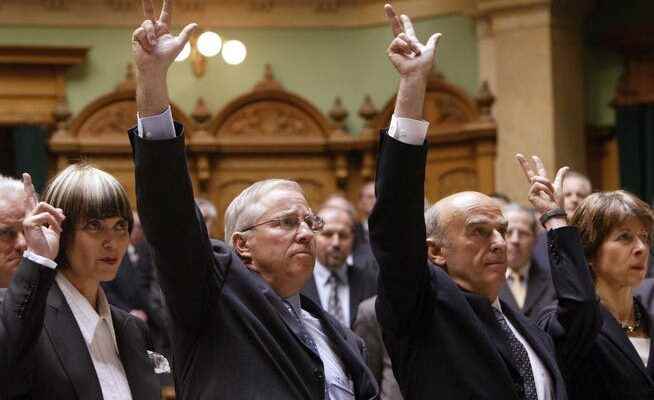There are almost ten weeks left until the election of a replacement to succeed Ueli Maurer. How things will continue now, who can be elected and what can happen on election day.
Micheline Calmy-Rey, Christoph Blocher, Hans-Rudolf Merz and Chancellor Annemarie Huber after their election in December 2003.
As soon as a Federal Councilor announces his resignation, the backroom discussions begin. As a rule, potential candidates keep a low profile for as long as possible: those who actually have ambitions for the office of the Federal Council first sound out their chances of being elected in Parliament before making their candidacy public. Cantonal parties often nominate their candidates for the attention of the national parent party. This in turn nominates their official candidates.
In multilingual, federalist Switzerland, the composition of the Federal Council plays a central role. Parliament therefore ensures that the language regions, cantons and genders are appropriately represented. In the early days of the federal state, the federal constitution stipulated that each canton may appoint a maximum of one federal councillor. This should prevent the large cantons from dominating. Since 1999, the rule has been formulated more openly in the constitution: “It must be taken into account that the regional and language regions are adequately represented”.
The representation of the parts of the country always leads to discussions. For example, Urs Schwaller (CVP) from Freiburg caused criticism when he came into play to succeed Pascal Couchepin (FDP) and, as a German speaker, acted as a representative of a predominantly French-speaking canton.
There are still cantons that have never had a Federal Council (Schaffhausen, Uri, Schwyz, Nidwalden and Jura). French-speaking Switzerland has always been represented in the Federal Council since 1848, but not the Italian-speaking part. After Flavio Cotti (CVP) resigned in 1999, it took 18 years for Ticino to regain a seat in the state government with Ignazio Cassis (FDP).
The back and forth with the second SVP seat
Despite the losses in the 2019 federal elections, the SVP is still the strongest party in parliament with 25.6 percent of the vote. After winning the elections three years ago, the Greens are claiming a seat in the Federal Council. It is still unclear whether she will attack the seat of the SVP or wait for the general elections in December 2023. The party is expected to determine its strategy at an extraordinary parliamentary group meeting in October. The SVP has had two seats in the Federal Council since 2003, with one break after Christoph Blocher was voted out in 2007.

The voted-out Federal Councilor Christoph Blocher leaves the National Council chamber on December 13, 2007 after his farewell speech.
At that time, Eveline Widmer-Schlumpf from Graubünden was elected in Blocher’s place. As a reaction to this, the central board of SVP Switzerland excluded SVP Graubünden from SVP Switzerland. As a result, former Bündner SVP representatives founded the Civil Democratic Party (BDP), which Widmer-Schlumpf also joined. The remaining SVP Federal Councilor Samuel Schmid also joined the BDP in 2008 before resigning in the same year. After Widmer-Schlumpf’s resignation in 2015, the SVP regained its second seat with Guy Parmelin.
A first resignation often leads to a second. That was the case in 2018 when, after Johann Schneider-Ammann (FDP), Doris Leuthard (CVP/middle) also announced her resignation. In 2010, Hans-Rudolf Merz (FDP) announced his resignation. Moritz Leuenberger (SP) followed a short time later, paving the way for a double by-election. A double vacancy gives the parties more leeway in the search for suitable candidates for the successor.
In the case of an individual resignation, the pressure is on a single party to meet all expectations in terms of cantonal representation, (linguistic) regional origin and gender. But not always party tactical considerations are behind a double resignation. In 1982, Fritz Honegger (FDP) and Hans Hürlimann (CVP) resigned together for reasons of state policy. They wanted to enable a renewal of the government.
Elected but not accepted the election
In the 20th century, single tickets were the norm. As a result, wild candidates were often elected to office – i.e. people who were not nominated by the parties. It also happened that candidates were elected but did not take office. The best-known example of recent history is Francis Matthey (SP). In 1993, four years after Elisabeth Kopp (FDP) resigned, the SP wanted a second woman in the Bundesrat. She nominated Ruth Dreifuss and Christiane Brunner, but Parliament chose the wild candidate Matthey. Under pressure from his party, he finally turned down the election.

Francis Matthey, a few days after the March 1993 election rejection.
In the 1990s, the two-person ticket prevailed. Triple tickets are rare, but they do occur: in 2017, the FDP nominated Ignazio Cassis, Isabelle Moret and Pierre Maudet to succeed Didier Burkhalter. This gives Parliament more choice. However, the party that nominates the candidate has less control over the election.
The savages in the majority
A by-election usually takes place in the session after receipt of the letter of resignation, traditionally on the Wednesday of the second week of the session. In the first two ballots, all eligible persons can be elected.
All Swiss nationals who have reached the age of 18 and who are not «are incapacitated because of mental illness or mental weakness», as stated in the Federal Constitution (Article 136). Political office is not a requirement. If you want to stand for election, you only have to submit your candidacy. In the case of by-elections, there are often several dozen wild applications.
After the third ballot, no further candidacies are permitted. Anyone who receives fewer than ten votes in the second or in one of the following ballots is eliminated. From the third ballot, the person who receives the fewest votes is eliminated. If there are several vacant seats, the election is based on the term of office of the previous incumbent. After the election, the preparations for taking office begin – according to the law, the newly elected Federal Councilor must take up work no later than two months after the election.
